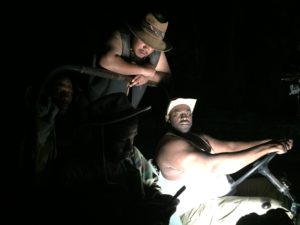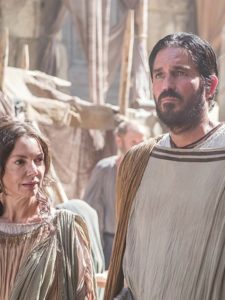…………………………………………………………………………………………………….
The Easter Effect and How It Changed the World
https://eppc.org/publications/the-easter-effect-and-how-it-changed-the-world/
The first Christians were baffled by what they called ‘the Resurrection.’ Their struggle to understand it brought about astonishing success for their faith
By George Weigel
March 30, 2018
In the year 312, just before his victory at the Battle of the Milvian Bridge won him the undisputed leadership of the Roman Empire, Constantine the Great had a heavenly vision of Christian symbols. That augury (sign) led him, a year later, to end all legal sanctions on the public profession of Christianity.
Or so a pious tradition has it.
But there’s a more mundane explanation for Constantine’s decision: He was a politician who had shrewdly decided to join the winning side. By the early 4th century, Christians likely counted for between a quarter and a half of the population of the Roman Empire, and their exponential growth seemed likely to continue.
How did this happen? How did a ragtag band of nobodies from the far edges of the Mediterranean world become such a dominant force in just two and a half centuries? The historical sociology of this extraordinary phenomenon has been explored by Rodney Stark of Baylor University, who argues that Christianity modeled a nobler way of life than what was on offer elsewhere in the rather brutal society of the day. In Christianity, women were respected as they weren’t in classical culture and played a critical role in bringing men to the faith and attracting converts. In an age of plagues, the readiness of Christians to care for all the sick, not just their own, was a factor, as was the impressive witness to faith of countless martyrs. Christianity also grew from within because Christians had larger families, a byproduct of their faith’s prohibition of contraception, abortion and infanticide.
For theologians who like to think that arguments won the day for the Christian faith, this sort of historical reconstruction is not particularly gratifying, but it makes a lot of human sense. Prof. Stark’s analysis still leaves us with a question, though: How did all that modeling of a compelling, alternative way of life get started? And that, in turn, brings us back to that gaggle of nobodies in the early first century A.D. and what happened to them.
What happened to them was the Easter Effect.
There is no accounting for the rise of Christianity without weighing the revolutionary effect on those nobodies of what they called “the Resurrection”: their encounter with the one whom they embraced as the Risen Lord, whom they first knew as the itinerant Jewish rabbi, Jesus of Nazareth, and who died an agonizing and shameful death on a Roman cross outside Jerusalem. As N.T. Wright, one of the Anglosphere’s pre-eminent biblical scholars, makes clear, that first generation answered the question of why they were Christians with a straightforward answer: because Jesus was raised from the dead.
Now that, as some disgruntled listeners once complained about Jesus’ preaching, is “a hard saying.” It was no less challenging two millennia ago than it is today. And one of the most striking things about the New Testament accounts of Easter, and what followed in the days immediately after Easter, is that the Gospel writers and editors carefully preserved the memory of the first Christians’ bafflement, skepticism and even fright about what had happened to their former teacher and what was happening to them.
In Mark’s gospel, Mary Magdalene and other women in Jesus’ entourage find his tomb empty and a young man sitting nearby telling them that “Jesus of Nazareth, who was crucified…has risen; he is not here.” But they had no idea what that was all about, “and went out and fled from the tomb…[and] said nothing to anyone, for they were afraid.”
Entering the tomb, they saw a young man sitting at the right, wearing a white robe; and they were amazed. And he *said to them, “Do not be amazed; you are looking for Jesus the Nazarene, who has been crucified. He has risen; He is not here; behold, here is the place where they laid Him. “But go, tell His disciples and Peter, ‘He is going ahead of you to Galilee; there you will see Him, just as He told you.'” They went out and fled from the tomb, for trembling and astonishment had gripped them; and they said nothing to anyone, for they were afraid.
(Mark 16:5-8 NASB)
Two disciples walking to Emmaus from Jerusalem on Easter afternoon haven’t a clue as to who’s talking with them along their way, interpreting the scriptures and explaining Jesus’ suffering as part of his messianic mission. They don’t even recognize who it is that sits down to supper with them until he breaks bread and asks a blessing: “…and their eyes were opened and they recognized him.” They high-tail it back to Jerusalem to tell the other friends of Jesus, who report that Peter has had a similarly strange experience, but when “Jesus himself stood among them…they were startled and frightened, and supposed that they saw a ghost.”
While they were telling these things, He Himself stood in their midst and *said to them, “Peace be to you.” But they were startled and frightened and thought that they were seeing a spirit.
(Luke 24:36-37 NASB)
Some time later, Peter, John and others in Jesus’ core group are fishing on the Sea of Tiberias. “Jesus stood on the beach,” we are told, “yet the disciples did not know that it was Jesus.” At the very end of these post-Easter accounts, those whom we might expect to have been the first to grasp what was afoot are still skeptical. When that core group of Jesus’ followers goes back to Galilee, they see him, “but some doubted.”
But Thomas, one of the twelve, called Didymus, was not with them when Jesus came. So the other disciples were saying to him, “We have seen the Lord!” But he said to them, “Unless I see in His hands the imprint of the nails, and put my finger into the place of the nails, and put my hand into His side, I will not believe.” After eight days His disciples were again inside, and Thomas with them. Jesus *came, the doors having been shut, and stood in their midst and said, “Peace be with you.” Then He *said to Thomas, “Reach here with your finger, and see My hands; and reach here your hand and put it into My side; and do not be unbelieving, but believing.” Thomas answered and said to Him, “My Lord and my God!” Jesus *said to him, “Because you have seen Me, have you believed? Blessed are they who did not see, and yet believed.” (John 20:24-29 NASB)
This remarkable and deliberate recording of the first Christians’ incomprehension of what they insisted was the irreducible bottom line of their faith teaches us two things. First, it tells us that the early Christians were confident enough about what they called the Resurrection that (to borrow from Prof. Wright) they were prepared to say something like, “I know this sounds ridiculous, but it’s what happened.” And the second thing it tells us is that it took time for the first Christians to figure out what the events of Easter meant—not only for Jesus but for themselves. As they worked that out, their thinking about a lot of things changed profoundly, as Prof. Wright and Pope Emeritus Benedict XVI help us to understand in their biblical commentaries.
The way they thought about time and history changed.
During Jesus’ public ministry, many of his followers shared in the Jewish messianic expectations of the time: God would soon work something grand for his people in Israel, liberating them from their oppressors and bringing about a new age in which (as Isaiah had prophesied) the nations would stream to the mountain of the Lord and history would end. The early Christians came to understand that the cataclysmic, world-redeeming act that God had promised had taken place at Easter. God’s Kingdom had come not at the end of time but within time—and that had changed the texture of both time and history. History continued, but those shaped by the Easter Effect became the people who knew how history was going to turn out. Because of that, they could live differently. The Easter Effect impelled them to bring a new standard of equality into the world and to embrace death as martyrs if necessary—because they knew, now, that death did not have the final word in the human story.
The way they thought about “resurrection” changed.
Pious Jews taught by the reforming Pharisees of Jesus’ time believed in the resurrection of the dead. Easter taught the first Christians, who were all pious Jews, that this resurrection was not the resuscitation of a corpse, nor did it involve the decomposition of a corpse. Jesus’ tomb was empty, but the Risen Lord appeared to his disciples in a transformed body. Those who first experienced the Easter Effect would not have put it in these terms, but as their understanding of what had happened to Jesus and to themselves grew, they grasped that (as Benedict XVI put it in “Jesus of Nazareth–Holy Week”) there had been an “evolutionary leap” in the human condition. A new way of being had been encountered in the manifestly human but utterly different life of the one they met as the Risen Lord. That insight radically changed all those who embraced it.
Which brings us to the next manifestation of the Easter Effect among the first Christians:
The way they thought about their responsibilities changed.
What had happened to Jesus, they slowly began to grasp, was not just about their former teacher and friend; it was about all of them. His destiny was their destiny. So not only could they face opposition, scorn and even death with confidence; they could offer to others the truth and the fellowship they had been given. Indeed, they had to do so, to be faithful to what they had experienced. Christian mission is inconceivable without Easter. And that mission would eventually lead these sons and daughters of Abraham to the conviction that the promise that God had made to the People of Israel had been extended to those who were not sons and daughters of Abraham. Because of Easter, the gentiles, too, could be embraced in a relationship—a covenant—with the one God, which was embodied in righteous living.
The way they thought about worship and its temporal rhythms changed.
For the Jews who were the first members of the Jesus movement, nothing was more sacrosanct than the Sabbath, the seventh day of rest and worship. The Sabbath was enshrined in creation, for God himself had rested on the seventh day. The Sabbath’s importance as a key behavioral marker of the People of God had been reaffirmed in the Ten Commandments. Yet these first Christians, all Jews, quickly fixed Sunday as the “Lord’s Day,” because Easter had been a Sunday. Benedict XVI draws out the crucial point here:
“Only an event that marked souls indelibly could bring about such a profound realignment of the religious culture of the week. Mere theological speculations could not have achieved this… [The] celebration of the Lord’s day, which was characteristic of the Christian community from the outset, is one of the most convincing proofs that something extraordinary happened [at Easter]—the discovery of the empty tomb and the encounter with the Risen Lord.”
Without the Easter Effect, there is really no explaining why there was a winning side—the Christian side—for Constantine the Great to choose. That effect, as Prof. Wright puts it, begins with, and is incomprehensible without, the first Christians’ conviction that “Jesus of Nazareth was raised bodily to a new sort of life, three days after his execution.” Recognizing that does not, of course, convince everyone. Nor does it end the mystery of Easter. The first Christians, like Christians today, cannot fully comprehend resurrected life: the life depicted in the Gospels of a transphysical body that can eat, drink and be touched but that also appears and disappears, unbothered by obstacles like doors and distance.
Nor does Easter mean that everything is always going to turn out just fine, for there is still work to be done in history. As Benedict XVI put it in his 2010 Easter message: “Easter does not work magic. Just as the Israelites found the desert awaiting them on the far side of the Red Sea, so the Church, after the Resurrection, always finds history filled with joy and hope, grief and anguish. And yet this history is changed…it is truly open to the future.”
Which perhaps offers one final insight into the question with which we began: How did the Jesus movement, beginning on the margins of civilization and led by people of seeming inconsequence, end up being what Constantine regarded as the winning side? However important the role of sociological factors in explaining why Christianity carried the day, there also was that curious and inexplicable joy that marked the early Christians, even as they were being marched off to execution. Was that joy simply delusion? Denial?
Perhaps it was the Easter Effect: the joy of people who had become convinced that they were witnesses to something inexplicable but nonetheless true. Something that gave a superabundance of meaning to life and that erased the fear of death. Something that had to be shared. Something with which to change the world.
Mr. Weigel is distinguished senior fellow at the Ethics and Public Policy Center, where he holds the William E. Simon Chair in Catholic Studies.
…
 “Hello Dwayne! I hope you’ve been well since that last time we saw each other! Such a random and strange story, as you may or may not already know, I’ve lived in LA for the past 4 1/2 years working in the film industry as I was pursuing back when we shot with a camera hanging out of your plane! I’ve been back in Arkansas not only shooting a feature film but also working on a television series for TBN (Trinity Broadcasting Network). The largest Christian broadcast network in the world. We’re shooting a 10 part series based on the best selling book, Chase The Lion by Mark Batterson. That said, we’ve shot all but one and we’re shooting the last episode on April 28th which is what’s leading to my message.
“Hello Dwayne! I hope you’ve been well since that last time we saw each other! Such a random and strange story, as you may or may not already know, I’ve lived in LA for the past 4 1/2 years working in the film industry as I was pursuing back when we shot with a camera hanging out of your plane! I’ve been back in Arkansas not only shooting a feature film but also working on a television series for TBN (Trinity Broadcasting Network). The largest Christian broadcast network in the world. We’re shooting a 10 part series based on the best selling book, Chase The Lion by Mark Batterson. That said, we’ve shot all but one and we’re shooting the last episode on April 28th which is what’s leading to my message.  Last night at about 3AM I saw some pics you posted in a field with a plane, and accompanied by an old Jeep. I’ve been scouring the area for a Jeep nearly identical to that, that could serve as a picture vehicle in the last short we’re doing, which would be driven down a road by four Congolese rebels before they “kill” the well know Missionary J.W. Tucker. All of that to say, I wanted to reach out and see if this is even in the realm of possibility! Would love to chat more if so! Just let me know a time we can connect! All the best, Dwayne!”
Last night at about 3AM I saw some pics you posted in a field with a plane, and accompanied by an old Jeep. I’ve been scouring the area for a Jeep nearly identical to that, that could serve as a picture vehicle in the last short we’re doing, which would be driven down a road by four Congolese rebels before they “kill” the well know Missionary J.W. Tucker. All of that to say, I wanted to reach out and see if this is even in the realm of possibility! Would love to chat more if so! Just let me know a time we can connect! All the best, Dwayne!” My brother agreed to loan his Jeep for the project to honor the fallen missionary. I delivered it to a set on the banks of the Arkansas River about 5 p.m. yesterday. Amazingly my good friend Gary Phillips showed up about the same time as an extra for the movie, and was assigned to drive the Jeep, which was a relief for me because I know how my brother values his Jeep! :), and at 12:30 a.m. this morning, after watching the shooting of the last four scenes, I loaded the Jeep and headed to the house to sleep, full of wonder and amazement at God’s working in the lives of His friends, through the centuries and extending on to “Today” and until “That Day.” “Those are the two most important days for each of us, whether we know it or not,” our preacher said in his sermon today.
My brother agreed to loan his Jeep for the project to honor the fallen missionary. I delivered it to a set on the banks of the Arkansas River about 5 p.m. yesterday. Amazingly my good friend Gary Phillips showed up about the same time as an extra for the movie, and was assigned to drive the Jeep, which was a relief for me because I know how my brother values his Jeep! :), and at 12:30 a.m. this morning, after watching the shooting of the last four scenes, I loaded the Jeep and headed to the house to sleep, full of wonder and amazement at God’s working in the lives of His friends, through the centuries and extending on to “Today” and until “That Day.” “Those are the two most important days for each of us, whether we know it or not,” our preacher said in his sermon today.







